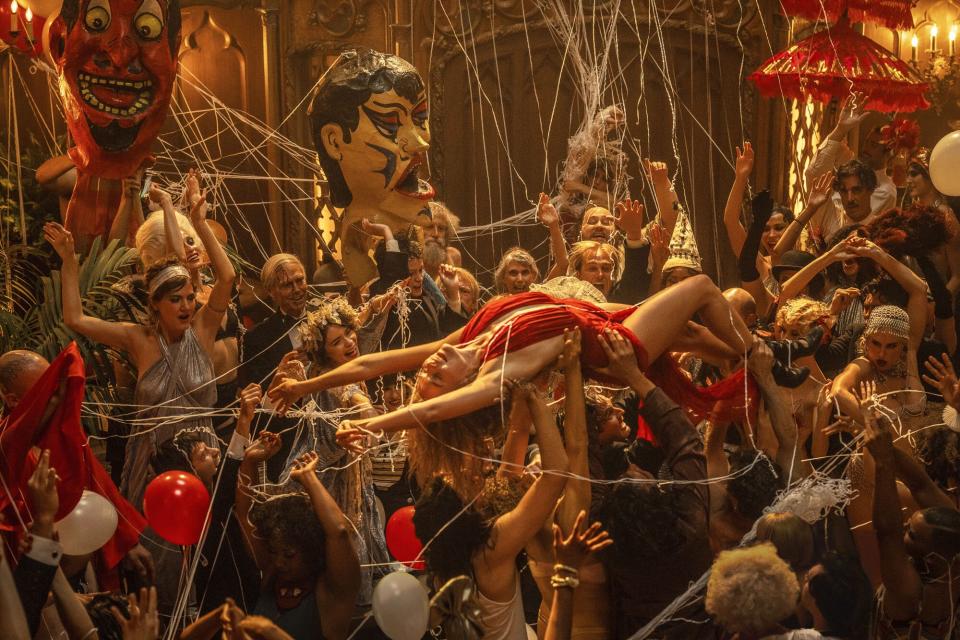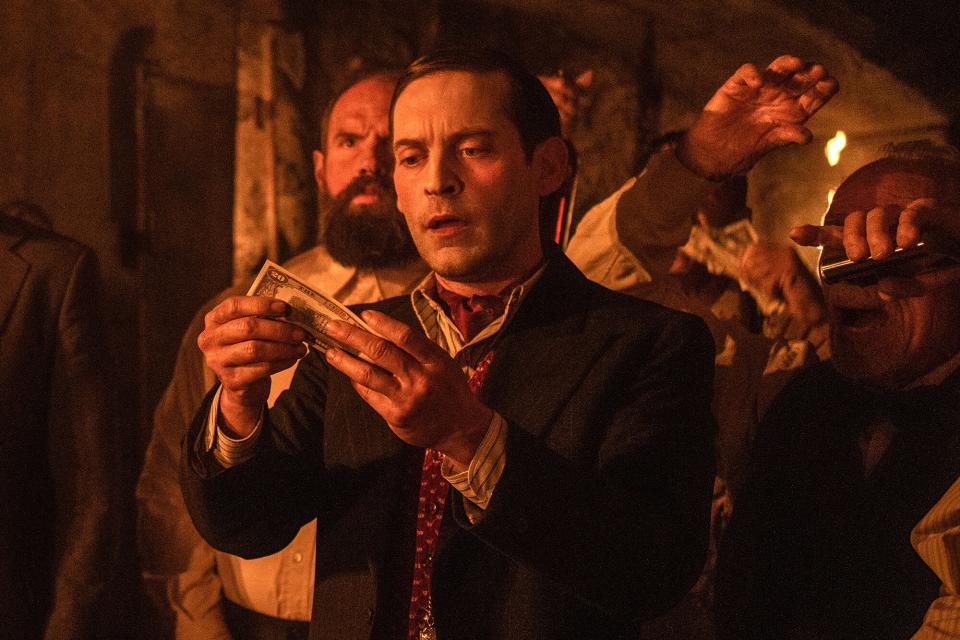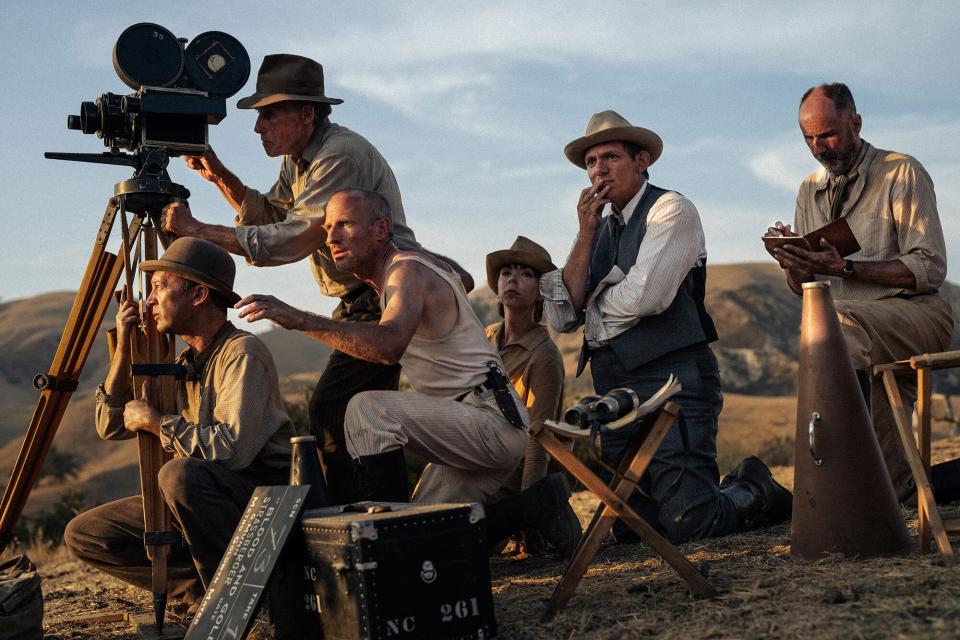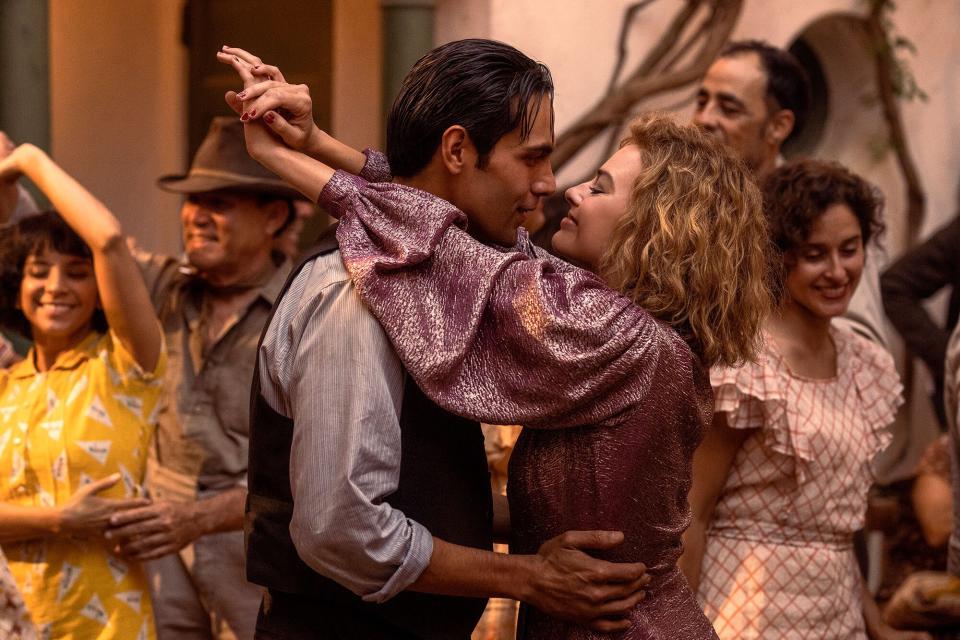Damien Chazelle on Babylon 's 'orgiastic behavior' and trippy ending
- Oops!Something went wrong.Please try again later.
- Oops!Something went wrong.Please try again later.
Warning: This article contains spoilers for Babylon.
When it comes to Damien Chazelle's latest film, Babylon, one thing is certain: La La Land it's not.
The writer and director tells EW he wanted to make that obvious right from the beginning. This is why the movie, set amid the backdrop of nascent Hollywood's transition from silents to talkies, begins with a stressed-out elephant having a massive bowel movement all over the camera lens.
"You want to give them a sense of the kind of movie it is, in a way that maybe is deliberately shocking," Chazelle tells EW. "You wind up declaring, rather overtly, exactly what the parameters of the film are." In the case of his 2016 Oscar-winning film, that meant starting with the "most musical musical number," "Another Day of Sun," and with Babylon, that meant starting with "certainly one of the most literally in-your-face gags."
Preconceived notions out of the way, Babylon proceeds from one wild scene to the next: everything from raging orgy-filled parties and snake fights, to moments of swoon-worthy movie magic and a mind-boggling acid-trip of an ending. Here, Chazelle explains his choices.

Scott Garfield/Paramount Damien Chazelle behind the scenes of 'Babylon'
Faking the elephant
Don't worry, animal lovers: No real-life pachyderms were ever in bowel distress on the Babylon set.
Chazelle, who is a fan of doing just about everything practically, says that no real elephants were used at any point. But there was always some physical prop on set to create the moment.
"The elephant was a buck that was manned by puppeteers," he says. "And what you see on screen is a mixture sometimes of in-camera puppeted latex, like the trunk, and then sometimes it was just a buck that then got CGI'd over."
In the scene in question, an elephant is being transported to a lavish party in Hollywood, when the vehicle gets stuck going up a hill, distressing the animal and causing it to unload its bowels — also not CGI. "All of that was practical, so not real, but you know, a practical substance," Chazelle says with a laugh. (He doesn't say what his substitute elephant poo actually was.)

Scott Garfield/Paramount Pictures Nellie LaRoy (Margot Robbie) is carried aloft during a big-scale Hollywood production in 'Babylon.'
Party like it's 1929
Chazelle knew he wanted Babylon, unlike his past films, to cover a big ensemble of characters who maybe weren't all intrinsically connected. The challenge, then, was to find ways to bring everyone together at pivotal moments in the film, and what brings Hollywood together better than a party?
"Parties and festivities were the only real way to justify them assembling," the Oscar winner says. "And then, once I started thinking along those terms, knowing that there would be at least a few party sequences, that became for me a portrait of a society."
Parties also allow a peek into the Hollywood pecking order, says Chazelle — who's on the list, who has to sneak in, who's thrown out — and with each event it changes.
"The parties themselves have shifted because they reflect what's accepted by society at the time," he explains. So there's the "Wild West sensibility" of the party in the beginning that sets the tone of that version of early Hollywood, for all its excesses and ugliness. Chazelle describes that version of Tinseltown as "able to stand up, wipe itself off, sweep its crimes under the rug, and keep making movies."
The pool party and ensuing snake fight later in the film epitomize the idea that "the wheels are starting to come off the wagon a little bit," Chazelle says. "Something's dying here, something that's either not going to last or we've already passed the end."
Then there's the Hearst party — the tuxedo-filled soiree that Margot Robbie's starlet and Jean Smart's gossip columnist go to — that, according to Chazelle, "becomes emblematic of what now is acceptable in Hollywood and what the party is supposed to be, comporting much more to our own preconceptions of what old Hollywood was like."
Lastly, there's Babylon's final Dante's Inferno-esque party involving Tobey Maguire's character.
"It's that seedy mirror image — the really depraved, awful, horror-movie mirror image, where everything that you could brush aside as funny or silly early on, now is just really not fun anymore," Chazelle says.

Scott Garfield/Paramount Tobey Maguire in 'Babylon'
"Orgiastic behavior"
For all their differences, each party in the film is jam-packed with some variation of drugs, drinking, dancing, orgies, and hundreds of extras — sometimes all in one frame. This posed one of the biggest logistic challenges of the film.
"It's hard, because obviously you need a certain number of extras, but each extra needs something to do," Chazelle says. "And so you need to choreograph that activity." Enter famed choreographer Mandy Moore, who previously worked with Chazelle on La La Land, who came in to assist, per the director, "with anything that felt even vaguely like dance, and sometimes beyond really what you would call dance."
Chazelle also enlisted intimacy coordinator Michael Arnold for the film's sexier moments. "He dubs himself the sex choreographer. So he would go in — again, very much with the choreographer's mindset in some ways — and help orchestrate various instances of orgiastic behavior," says the filmmaker.
And then there's the drugs of it all. "You want everyone to feel and look drunk and high, even though they aren't, and even though you had an early morning on set, and you're doing take 47," Chazelle admits. "So trying to balance the logistics that needed to be wrangled with the freedom that we wanted to convey as a feeling. That's the tricky thing, because you couldn't just say, 'Okay, everyone improvise!' because then it would just ultimately be like throwing too many colors onto a canvas. It just becomes mud."
Fangs for the memories
One of Babylon's most unhinged moments is the aforementioned snake scene, in which Robbie's character, Nellie LaRoy, after a wild night of partying, decides to fight a snake in the desert while most of the rest of the cast watches on. Naturally, things don't go well, and Nellie ends up getting bit in the jugular.
Of course, none of the actors handled a real snake, though there were some present. "When the camera pans over and you just see the snake on its own lying on the ground or something, those were all real snakes, who were amazing to shoot because you really you feel like they're looking right at the lens and sort of reacting to the cameras — it's unbelievable," Chazelle says.
However, when it came time for the actors to actually do the meat of that scene, it was a combo of puppets, leather, some CG stitching, and separate fake snake-head pieces for when the reptile gets removed from Nellie's neck. There was also a wound appliance for the snake jaw to latch on to.
As for what Chazelle hoped to accomplish with this wild scene, he says, "It was a fitting place for that portion of the movie to end — something base and stupid and, I guess you could say, primal on a sort of evolutionary level, as just like human beings gathering together to fight some wild animal that they have no business fighting. There was something to me that felt a little bit apropos to Hollywood, for whatever perverse reason."

Scott Garfield/Paramount A film crew attempting to get the perfect shot in 'Babylon'
Margot's fist, meet the set
One of Babylon's standout sequences is when Nellie has her first big role in a talkie. The sync-sound technology is clearly new and difficult for everyone to use, and they spend an entire grueling day of take after take on one tiny piece of dialogue, before finally getting it right.
In the film, everyone loses their mind when they finally get the take, but what was it like behind the scenes? In some ways it was one of the easier parts of the film to make, recalls Chazelle.
"Technically, it was one of the more comfortable scenes to shoot because we were on a soundstage," he says. "And it was a very precisely storyboarded scene, the camera doesn't move much. But each individual shot wasn't the hardest thing ever."
However, as things get more intense for the characters in the film, things behind the scenes mirrored that energy a bit. "I remember one take Margot punched a hole through the set," the director remembers. "I never had an actor do that, literally just punch a full hole through, I think it was through a window. She somehow miraculously was fine, but the window was shattered. She was fine, but the set was destroyed."

Scott Garfield/Paramount Manny (Diego Calva) and Nellie (Margot Robbie) share a moment in 'Babylon'
Reeling in the years
Babylon concludes with a trippy reel of film clips and colors, taking ex-producer Manuel "Manny" Torres (Diego Calva) and the audience through a delirious snapshot of Hollywood's history, even leading up to present day with brief shots of Avatar. Though Chazelle hopes that viewers will come to their own conclusions about what the ending means, he's happy to share what his thought process was.
"I think it's a bit of the idea of someone, in this case Manny, reflecting on his life, and through that reflection, reflecting on his place in the bigger scheme of things," the writer-director offers. "And his place as being, in some ways, one solitary frame in the infinite reel of celluloid that is the history of this art form that he was a part of, and then the history of the moving image — and I do think that's a history of death and rebirth."
Chazelle says this is why it was so important to him that Babylon be "merciless and brutal" in its second half.
"Hollywood is a machine that chews people up and spits them out — it's the great equalizer," he says. "There's a brutality that comes from that. But it's inextricable from the rebirth that follows."
This is why Chazelle thinks that everyone, since the dawn of the industry, has lamented that the art form is dying or doesn't have a future. "These kind of paradigm shifts come and go, the same way that careers come and go, and movie stars come and go. That, on some level, is very scary, and it can even be depressing. But on another level, and hopefully this is where Manny kind of reaches a place of peace at the end, it's comforting, because you can't help but be aware of how much bigger it is than you, and how you're a part of something bigger. Just to be a small part of that is, in its own way, really special and eternal."
Related content:

